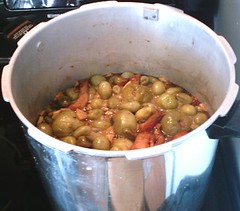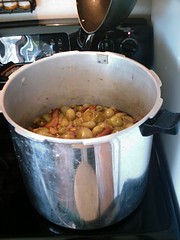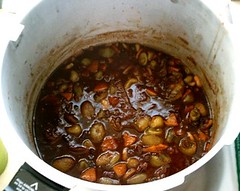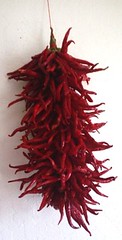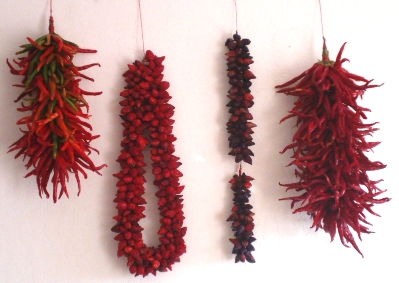It’s ridiculous, the lengths some people will go to, to be holiday-esque.
The thought was: “Ooh! Chestnuts! Let’s roast them on our Thanksgiving beach bonfire!” The reality was: “The coast in November is bloody cold, and the windchill is making it below forty, and what were we thinking, bring a post-surgical child out here in the dark, not to mention trying to lug firewood and marshmallows out here while keeping track of irresponsible teen-aged pyromaniacs?!” So, no 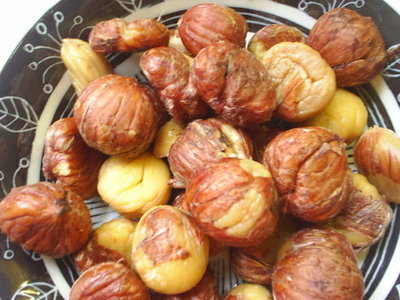 chestnuts roasted on an open fire (but marshmallows roasted over candles: good fun. Except for that bit with the sooty wax. And the skewers on fire. Look, I said pyromaniacs…) At any rate, post-holiday, we were left with a great bag of beautifully smooth nuts which look gorgeous, but which are just too …something for my taste. Sweet? Starchy? Something. Really, I’m just not that big on nuts, and I don’t care for even things like pecans and macadamia nuts, which most people are wild about, but I try to eat some nuts every once in a bit, because they’re supposed to be full of copper and trace elements Americans don’t get, unless they’re combined with sports and beer — which aren’t two of my big interests either. But I digress. Me, with bag of glossy brown nuts, rapidly rotting (NEVER have I run across any nut that decomposes so fast. Ugh!). So, my idea was an autumnal soup. I came up with one that combined a chestnut soup from a Vegan Lunchbox recipe with leftover roasted butternut squash and pureéd the whole thing. That cut the cloying sweetness/richness of the chestnuts, to good effect, but the fact is that peeling/shelling the rotten things was a huge pain in the neck — and in the thumbs. Tasty though it was, I am not surprisingly more fond of soups that take less work.
chestnuts roasted on an open fire (but marshmallows roasted over candles: good fun. Except for that bit with the sooty wax. And the skewers on fire. Look, I said pyromaniacs…) At any rate, post-holiday, we were left with a great bag of beautifully smooth nuts which look gorgeous, but which are just too …something for my taste. Sweet? Starchy? Something. Really, I’m just not that big on nuts, and I don’t care for even things like pecans and macadamia nuts, which most people are wild about, but I try to eat some nuts every once in a bit, because they’re supposed to be full of copper and trace elements Americans don’t get, unless they’re combined with sports and beer — which aren’t two of my big interests either. But I digress. Me, with bag of glossy brown nuts, rapidly rotting (NEVER have I run across any nut that decomposes so fast. Ugh!). So, my idea was an autumnal soup. I came up with one that combined a chestnut soup from a Vegan Lunchbox recipe with leftover roasted butternut squash and pureéd the whole thing. That cut the cloying sweetness/richness of the chestnuts, to good effect, but the fact is that peeling/shelling the rotten things was a huge pain in the neck — and in the thumbs. Tasty though it was, I am not surprisingly more fond of soups that take less work.
Now that the cool, wet weather has come in to stay for a bit, the farm is churning out those cool, wet weather veggies, most notably leeks and carrots, broccoli, cauli, and soon, peas. Apparently myriad other cultures have long regarded the whole carrot — as well as the tops of radishes, beets, and other greens part of the usual culinary circus, but most Californians I know don’t know what to do with any part of a carrot that isn’t orange. Admittedly, I used to put carrot tops in a vase and admire them for the fifteen seconds they would stay pretty, and my chiropop chick juices them — but then, she juices everything. (She also gives her sweater-wearing dog filtered water and B vitamins, so I’m going to reserve judgment on her input here.) I  decided, since I have an abundance of carrots and leeks from the farm box this week, to see if they’d make a decent soup. I tasted a piece of the top, and determined that it was a flavor close enough to celery to work well.
decided, since I have an abundance of carrots and leeks from the farm box this week, to see if they’d make a decent soup. I tasted a piece of the top, and determined that it was a flavor close enough to celery to work well.
I began by sauteéing onions and leeks, adding dry-leaf sage and then the chopped and cleaned carrot tops and six cups of stock. I finished with some mung bean noodles, just for fun, and it was really tasty. Mac suggested quinoa for next time, and I think carrot tops might also go well with barley. This is what I’m going to try next for my Carrot Top Soup:
- 1 ½ cup chopped carrot tops – and any carrots that go with them, diced *You can make this without adding the carrots; I did.
- 2 tblspns olive oil
- ½ cup short grain rice or quinoa
- 2 large leeks, white part only
- a clove of garlic, smashed, or 1 tsp. garlic paste
- one stalk of celery, diced
- 2 pinches of rubbed sage
- 2 tblspns chopped dill or parsley
- 6 cups vegetable stock, plus ½c. white wine
- Salt and pepper to taste
After sauteèing the leeks, garlic, carrots and celery in your olive oil for about five minutes, pour on the white wine, give it another minute or so, then add your broth and bring to bubbling stage. Once your broth and veggies are boiling, add in your rice or quinoa, and your sage, then simmer for fifteen minutes until tender. Add the chopped carrot tops and cook for 5 more minutes, mixing well. The Italians serve a soup much like this over garlic-rubbed bread and sprinkled with parmesan. You could also add cubed potatoes in lieu of quinoa or rice. One of the best things about soup is that you can hardly mess it up, so I always enjoy making whatever variations on a theme I can come up with. It combats the rain and fog fug, makes the house smell wonderful, and fills me up so I don’t overdose on the lovely cranberry muffins being churned out of the oven.
It may not be exactly ‘holiday-esque,’ but it’s seasonal, which lasts longer.
A note about the booze, Julia… After another email to my collegiate friend in Spain, I realized I have a habit of coming up with all of these great recipes where one can just drop in a bit of white wine or rum, and all will be well… This is to disprove the Booze As Food thing I seem to have going: For the under 21 set, lemon juice, vinegar, vegetable stock or possibly even V8 will work as well as the other libations I’ve suggested. Don’t let me get you into trouble, Julia… it would be a shame to get kicked out of your university just for cooking, after everything else…
Cheers!

 decided, since I have an abundance of carrots and leeks from the farm box this week, to see if they’d make a decent soup. I tasted a piece of the top, and determined that it was a flavor close enough to celery to work well.
decided, since I have an abundance of carrots and leeks from the farm box this week, to see if they’d make a decent soup. I tasted a piece of the top, and determined that it was a flavor close enough to celery to work well. popping things in the oven and topping them with whipped cream. A little research informs me that in reality, this dish is called “Indian” pudding because the early settlers referred to the main ingredient as “Indian meal” – the meal used by the First Nation peoples. Generally, John and Mary Puritan weren’t all that creative, so any recipe using Indian meal as the main ingredient was called Indian… . Over time, the plant became known as corn, and the meal made from it as corn meal.
popping things in the oven and topping them with whipped cream. A little research informs me that in reality, this dish is called “Indian” pudding because the early settlers referred to the main ingredient as “Indian meal” – the meal used by the First Nation peoples. Generally, John and Mary Puritan weren’t all that creative, so any recipe using Indian meal as the main ingredient was called Indian… . Over time, the plant became known as corn, and the meal made from it as corn meal. hour.
hour.
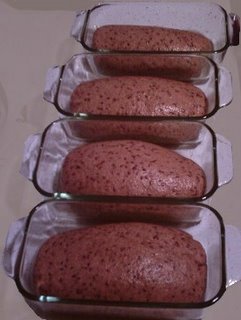
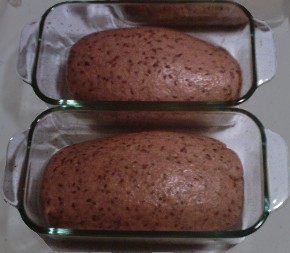
 actually funny. But, never fear, we who Wish We Were Baking will always find a way… and a means… and a little bit of dough…
actually funny. But, never fear, we who Wish We Were Baking will always find a way… and a means… and a little bit of dough…